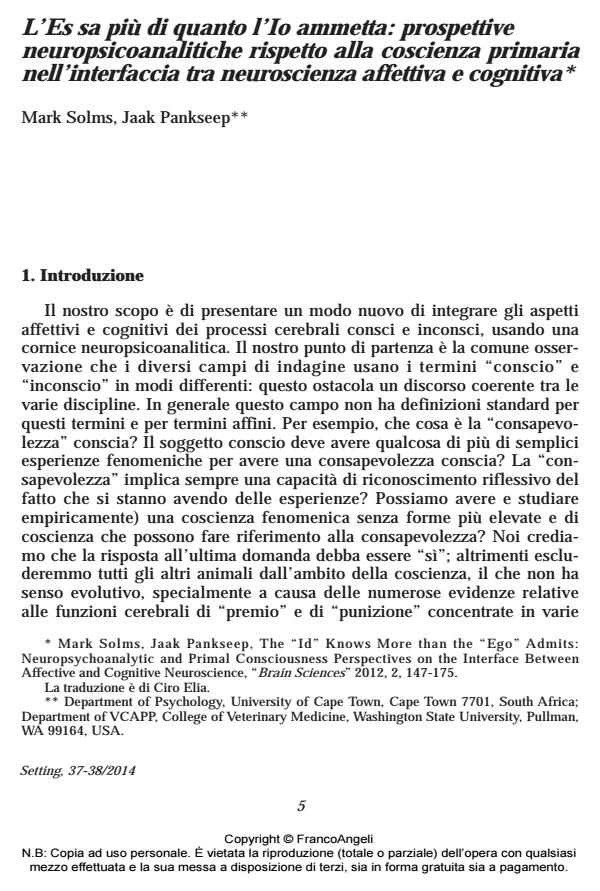L’Es sa più di quanto l’Io ammetta: prospettive neuropsicoanalitiche rispetto alla coscienza primaria nell’interfaccia tra neuroscienza affettiva e cognitiva
Titolo Rivista SETTING
Autori/Curatori Mark Solms, Jaak Pankseep
Anno di pubblicazione 2015 Fascicolo 2014/37-38
Lingua Italiano Numero pagine 38 P. 5-42 Dimensione file 659 KB
DOI 10.3280/SET2014-037001
Il DOI è il codice a barre della proprietà intellettuale: per saperne di più
clicca qui
Qui sotto puoi vedere in anteprima la prima pagina di questo articolo.
Se questo articolo ti interessa, lo puoi acquistare (e scaricare in formato pdf) seguendo le facili indicazioni per acquistare il download credit. Acquista Download Credits per scaricare questo Articolo in formato PDF

FrancoAngeli è membro della Publishers International Linking Association, Inc (PILA)associazione indipendente e non profit per facilitare (attraverso i servizi tecnologici implementati da CrossRef.org) l’accesso degli studiosi ai contenuti digitali nelle pubblicazioni professionali e scientifiche
Si ritiene comunemente che la coscienza sia la funzione superiore del cervello. In questo articolo consideriamo la possibilità, basata su abbondanti dati neuroevolutivi, che le esperienze affettive e fenomeniche legate alla parte inferiore del cervello forniscano "l’energia" per la costruzione durante lo sviluppo delle forme più evolute della coscienza cognitiva. Questa visione è in accordo con molte formulazioni teoriche di Sigmund Freud. In questa riconcettualizzazione tutta la coscienza può dipendere dalla evoluzione originaria delle esperienze affettive e fenomeniche che hanno portato alla codifica dei valori utili alla sopravvivenza. Queste energie sottocorticali forniscono la base per la costruzione epigenetica delle forme superiori, percettive e non-percettive, della coscienza. In questa prospettiva, le esperienze percettive furono inizialmente affettive del tipo del processo primario e originantesi nel tronco encefalico; esse sono capaci di essere elaborate attraverso l’apprendimento secondario e i processi mnemonici e di evolvere nelle forme della cognizione terziaria della coscienza. In questa visione, benché tutte le attività neurali dell’individuo siano inconsce, le reti primarie sottocorticali delle emozioni e degli altri affetti primari, insieme ai meccanismi dell’apprendimento secondario e della memoria, possono essere state al servizio, come un’impalcatura senziente, dello sviluppo delle risolte attività mentali superiori e di quelle percettive che avvengono nella neocorteccia. I dati che sostengono questa visione neuro-psico-evolutiva della costituzione della mente vengono discussi e messi in relazione con i classici modelli psicoanalitici.
- Il Cobra di Pugacëv. Interventi a sorpresa nella lingua del paziente: una efficace manovra affettiva Emilio Bertuletti, in SETTING 48/2024 pp.137
DOI: 10.3280/SET2024-048005
Mark Solms, Jaak Pankseep, L’Es sa più di quanto l’Io ammetta: prospettive neuropsicoanalitiche rispetto alla coscienza primaria nell’interfaccia tra neuroscienza affettiva e cognitiva in "SETTING" 37-38/2014, pp 5-42, DOI: 10.3280/SET2014-037001